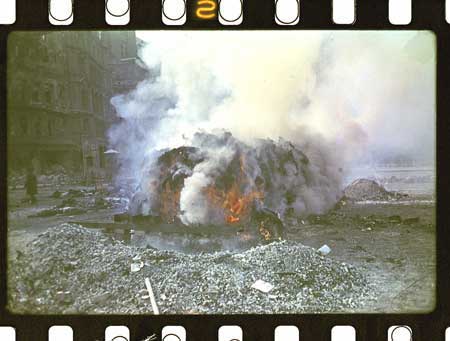| [All images added
by this website, and are copyright of this
website] 
Sunday, May 2, 2004  Victims
were cremated on huge funeral pyres for days after
the 1945 British raid. Air warfare 'expert"
Frederick Taylor: Dresdeners had it coming to them.
 David
Irving comments: I ALREADY responded to a similar
review
of the leftwing "historian" Frederick
Taylor's book on Dresden published by
David "Ratface" Cesarani in The
Independent earlier this year
2004.
Cesarani is one of the
first of a new wave of conformist (and
often Jewish) historians trying to justify
the Churchill government's air raid on
Dresden, which burned alive over one
hundred thousand people, mostly civilians,
in the space of two hours on February 13,
1945 fifty-nine years ago tonight.
Cesarani's thesis: They had it coming
to them.
If anybody were to
suggest the same of the Jews at the hands
of the Nazis, he would now be hauled off
to jail. But here we have Cesarani
criticizing my book, written forty-five
years ago, on the basis of a book written
years after the event by a leftwing
British author, who has made not a little
use of my own 1960s records and research,
while giving me scant credit.
One detail should
suffice to show who was correct: Cesarani
scoffs at the "obscene" notion that the
British government's aim was to teach the
Russians a lesson on the strength of the
RAF bomber hordes In his
seminal history of RAF Bomber Command,
author Max Hastings used a
document, a two volume British internal
monograph, Review of the Work of Int
I, which had eluded even my researches
-- and this quoted verbatim the briefing
notes sent by teleprinter to every
squadron of RAF Bomber Command taking part
that night.
To quote my book
Apocalypse
1945: the Destruction of Dresden:
"Bomber
Command head- quarters had issued by
teleprinter identical briefing
instructions to every bomber airfield. The
wording, which has survived, makes odd
reading now. The seven thousand British
airmen were to be told that afternoon that
they were about to attack Dresden, 'far
the largest unbombed built-up area the
enemy has got.' 'The intentions of the
attack are to hit the enemy where he will
feel it most,' the telex said; it then
added words pregnant with other
implications: 'And incidentally to show
the Russians when they arrive what Bomber
Command can do.'
The sporting phrase
which occurs to me right now is, I think,
Game, set and match. INCIDENTALLY, Henry
Stimson reveals in his diary that
one useful purpose of the Hiroshima
bombing would be to show the Russians the
strength of this new weapon. Here is a
passage from vol.iii of Churchill's
War (as yet unpublished, of
course): "It
was Stimson who formally suggested
employing the Bomb. The body-count would
be Japanese, but it was the effect on the
Russians that counted on him and other
statesmen now. As early as May 14, 1945,
after talking over this 'hot potato' with
General Marshall, he had dictated into his
files an opinion that the way to deal with
Russia now was to 'let our actions speak
for words.' The Russians, he felt, would
understand actions better than anything
else. 'We (Americans) have got to regain
the lead and perhaps do it in a pretty
rough and realistic way.' This time, he
had reminded Marshall, Washington held all
the cards -- 'a royal straight flush,' was
how he put it. 'We mustn't fool about the
way we play it,' he had said. 'We have
coming into action a weapon which will be
unique.'  The
order to drop the A-bomb
The
order to drop the A-bomb
|
Book
Review: 'Dresden' By Tom Blackburn, Special to The Palm Beach
Post DRESDEN:
Tuesday, February 13, 1945, by Frederick Taylor.
HarperCollins; 528 pages; $26.95. WHEN the World War II Allies
bombed Dresden,
Germany, in 1944, they attacked an undefended
target of no military value in a war already won.
The city was crammed with refugees, and the
firestorm killed more people than the atomic bombs
at Hiroshima or Nagasaki. It was an atrocity by
war-maddened democracies and a black mark against
their leaders' names. That's the story "everyone" knows. For
pacifists, it shows the horrors even of just wars.
To hawks, it proves "conventional" bombing is
deadly enough to make the nuclear bomb just another
weapon. It was convenient for Nazi propaganda
minister Josef
Goebbels, who thought it up, and for the
Soviet Union, which finally captured Dresden on the
last day of the war and ruled it until the
communist empire broke up. 
It's a great story, but Frederick Taylor,
a British expert on modern
Germany, had the wit to wonder how much of
the story is true. As it turns out, not much. Dresden wasn't undefended. It had flak guns, and
some fighters showed up when the Americans arrived
for the third attack of the day, but Berlin had
decided to concentrate its forces elsewhere.
Despite the lessons from other German cities,
Dresden had not prepared air-raid shelters. The
gauleiter, Martin Mutschmann, had a
state-of-the-art shelter at home, but -- wouldn't
you just know? -- supplies ran out before he got
around to protecting his followers. Dresden was a legitimate military target as a
center of war production; as one of two bottlenecks
for troops and supplies headed to and from the
Russian front; and as an administrative center for
the war in the East. The general defending the
Eastern front had a million troops at his disposal.
The war was hardly over. U.S. and British forces
were stuck at the Rhine, V-2 rockets were raining
down on England and Belgium, and the Russians would
lose 89,000 soldiers taking Berlin three months
later. Dresden wasn't a "refugee center." Tens of
thousands passed through, but authorities gave them
only a day to move on or not be fed. The city had
one day's intake of refugees when it was hit. It was hit with a heavy concentration designed
to produce a firestorm -- in which small fires
converged into a tornado-like blaze that sucked in
more combustibles if conditions were right.
Conditions were right. The British accidentally discovered the
possibilities at Hamburg. Their techniques were
developed from examining the Luftwaffe's
destruction of central Coventry. Taylor is not saying that war isn't hell. He is
showing, instead, that Dresden isn't emblematic of
anything about World War II. On a per-capita basis,
Pforzheim, which lost one-sixth of its population
and 83 percent of its built-up area, suffered more
grievously in its firestorm, and nobody shouts
Pforzheim to prove a point. Nobody did more to make Dresden a fighting word
than David Irving, the British historian
devoted to depicting Hitler as a poor,
misunderstood sketch artist who couldn't catch a
break. (Kurt Vonnegut contributed with his
semi-autobiographical Slaughterhouse Five, but as a
P.O.W. in Dresden, he was a target and took the
attacks personally. He didn't engage in
comparisons.) In The Destruction of Dresden, a 1963
bestseller, Irving reported a death toll from the
bombing of 135,000. After that number was shown to
be a fake, Irving retreated to "up to 100,000."
Careful study by Germans and Taylor puts the number
closer to between 25,000 and 40,000. That's mass carnage, but more in line with other
events of the war. The V-2 campaign being carried
on at the same time killed 2,754 Englishmen and
3,470 Belgians, mostly civilians. The number in
Dresden would have been lower had Mutschmann done
his job. Taylor has written a thickly layered history of
Dresden before, during and after Feb. 13-14, 1945.
He even brings to light an irony others overlooked.
Dresden was settled in the Dark Ages by invaders
from northwestern Germany -- Saxons. Another group
from the same tribe, at about the same time, gained
a toehold in eastern England -- in exactly the area
from which the bombers took off. But this book is the history of air warfare and
of propaganda more than of Saxony, and one wouldn't
be going too far to call it a brilliant piece of
work. Tom Blackburn is a retired
Palm Beach Post editorial writer. Copyright ©
2004, The Palm Beach Post.  
-
 Our dossier on Dresden
raid
Our dossier on Dresden
raid Our
dossier on Operation
THUNDERCLAP
1944/1945
Our
dossier on Operation
THUNDERCLAP
1944/1945-
 David Irving comments on Frederick Taylor,
Dresden, 13 February 1945: A
Radical's Diary
David Irving comments on Frederick Taylor,
Dresden, 13 February 1945: A
Radical's Diary  Cesarani: Dresden, a
Legitimate Target
Cesarani: Dresden, a
Legitimate Target  Marais
on Air War Statistics and Max Hastings'
history
Marais
on Air War Statistics and Max Hastings'
history-
-
|